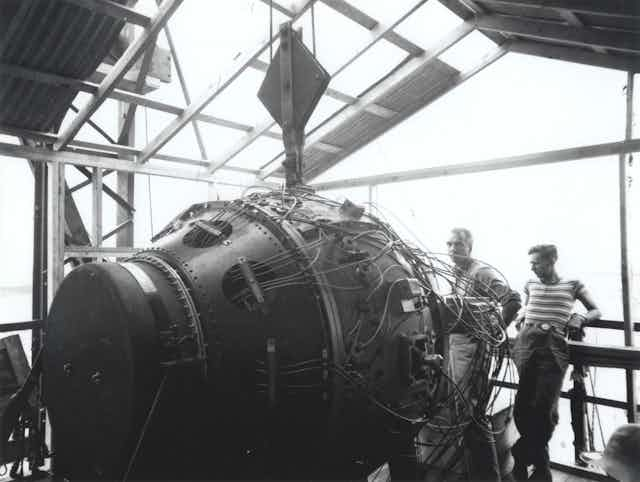Fifteen seconds before 5.30am on July 16 1945, above an area of New Mexico desert so unforgivingly dry that earlier travellers christened it the Jornada del Muerto (Journey of the Dead Man), a new sun flashed into existence and rose rapidly into the sky. It was a little before dawn.
This strange, early daybreak was the Trinity Test: humanity’s first encounter with the atomic bomb. Within a month two bombs were dropped on Japan: the first, “Little Boy”, a uranium weapon, at Hiroshima; the second, “Fat Man”, a plutonium weapon of the implosion design tested at Trinity, on Nagasaki. Casualty estimates vary widely, but perhaps as many as 150-250,000 people died as a direct result of these two events. The following half century was one of intense nuclear testing, the residue of which might be the signature for the proposed new epoch of the Anthropocene.
The extraordinary story of the Manhattan Project, which led to this point, has been told many times. It begins with the realisation that atomic weapons, releasing vast amounts of energy via a nuclear chain reaction, were possible. It includes a 1939 letter, signed by Albert Einstein, alerting President Roosevelt to the dangers of a German atomic bomb programme, and tells how, following the United States’ entry into the second world war after the Japanese attack on Pearl Harbor, the programme accelerated rapidly under the control of General Leslie Groves.
The Manhattan Project absorbed the British and Canadian “Tube Alloys” atomic programme, and drew on a dazzling array of scientific talent. More than a purely scientific endeavour, it was an engineering and industrial enterprise on a massive scale, employing about 130,000 people at its peak, and perhaps half a million cumulatively.

This article is part of Conversation Insights
The Insights team generates long-form journalism derived from interdisciplinary research. The team is working with academics from different backgrounds who have been engaged in projects aimed at tackling societal and scientific challenges.
Site Y was a town built from scratch to build the atomic bomb at Los Alamos, New Mexico. Here, under the scientific directorship of J Robert Oppenheimer – a complex, charismatic figure (so famous after the war that he was instantly recognisable by his porkpie hat) – scientists, including many who’d fled Nazi persecution in Europe and were acutely aware of what a Nazi bomb might mean, built the “gadget” tested at Trinity.
By then, though, circumstances had changed. In late 1944, as Allied forces advanced across Europe, it became apparent that the German bomb programme had stalled years before. After Franklin Roosevelt’s death in April 1945 and Germany’s defeat in May, the Trinity Test was prioritised so Harry Truman, the new president, would have news of it when he met Joseph Stalin and Winston Churchill at the Potsdam conference.
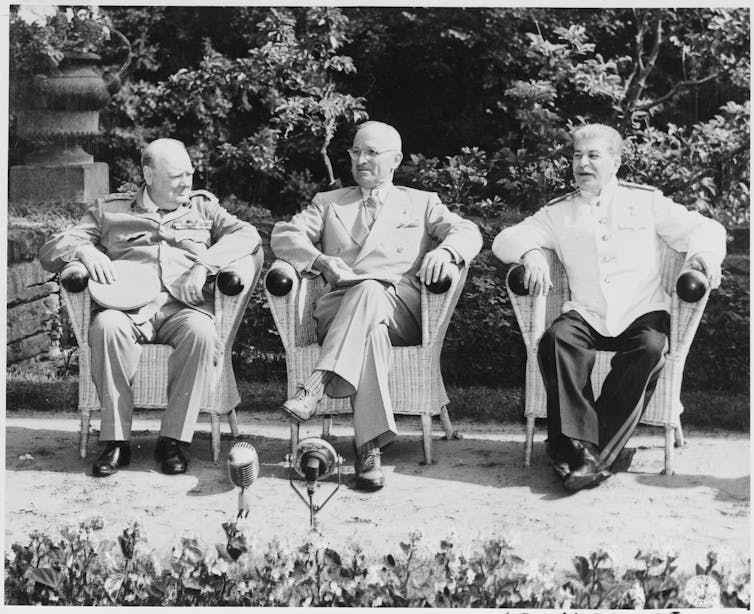
Trinity is a striking moment. Scientists, military personnel and observers gathered in observation bunkers 10,000 yards from ground zero, at a base camp ten miles away, and at Compañia Hill, 20 miles away. Overnight, thunder, lightning and rain swept across the area, imperilling the test.
Don Hornig, the last man to “babysit” the bomb in its metal shack at the top of a 100ft tower, recalls passing the time by reading an anthology of humorous writing, Desert Island Decameron, by the light of a 60-watt bulb. He hoped the wet tower would act as a lightning rod if there were any lightning strikes. The alternative was sobering, but he appears to have been philosophical: “It would set the bomb off. And in that case, I’d never know about it! So I read my book.”
At a 2am conference, Groves threatened hard-pressed project meteorologist, Jack Hubbard, insisting he sign his forecast predicting conditions would clear by dawn and promising to “hang” him if they didn’t. Groves then roused New Mexico’s governor by phone, warning him he might have to declare martial law if things went wrong. By 4am the skies were clearing.
As 5.30 approached, people readied themselves with welder’s glass to view the test. At Compañia Hill, the physicist, Edward Teller, passed around sun cream. At S-10000, the main control bunker, an exhausted Oppenheimer leaned against a post to steady himself as the final seconds ticked away, and was heard to mutter: “Lord, these affairs are hard on the heart.”
The story of the Manhattan Project often ends with the controversial use of the bomb on Japan, or goes on to tell about the leaking of atomic secrets by Klaus Fuchs and the first Soviet atomic test in 1949. It might add that Oppenheimer, frequently portrayed as a tragic figure, had his security clearance revoked amid the anti-communist hysteria of the early 1950s.
A new world
Now, 75 years on, it’s worth isolating Trinity from this complex history to ask what that early morning moment in the remote desert meant. It was here, after all, that humans first encountered phenomena that were to haunt the cold war imagination, and still shape how many imagine potential nuclear futures: the atomic flash, the mushroom cloud and radioactive fallout.
Although this was a new human experience (Norris Bradbury, who succeeded Oppenheimer as director of the Los Alamos National Laboratory, noted that “the atom bomb did not fit into any preconceptions possessed by anybody”), it was processed through cultural traditions with long histories. It’s become an origin story in nuclear mythologies.

Writers return repeatedly to Trinity as a moment pregnant with meaning. In the 21st century alone, it’s featured in novels by, among others, Lydia Millet, Ellen Klages, Nora Gallagher, TaraShea Nesbit, Elizabeth J Church and Louisa Hall, and there are notable earlier examples, including those by Pearl Buck, Leslie Marmon Silko and Joseph Kanon. It’s been depicted by poets from William E Stafford to John Canaday and Hannah Cooper-Smithson, and on stage by Tom Morton-Smith. It features in music in genres ranging from rock to opera.
This fascination with Trinity shows how it’s not only an important historical moment, but a critical cultural one too. As the old sun crept above the horizon a few minutes after the test, many present were in little doubt it was rising on a new world.
The brightest light
In both eyewitness accounts and in fiction, Trinity is described as a moment of rupture and rapture: rupture because it marks the transition from a pre-nuclear to a nuclear age; rapture because the encounter with dazzling light and a power overwhelming the senses has the quality of religious experience.
Of course, there can be distortion in such accounts. The popular tendency to see the atomic bomb as the definitive nuclear technology marginalises fields like nuclear medicine and ignores the intellectual richness of the nuclear sciences.
And there are other candidates for the beginning of the nuclear age: Hiroshima, for sure, but also perhaps the creation of the first self-sustaining chain reaction by Enrico Fermi’s team in Chicago in 1942, Lise Meitner and Otto Frisch’s description of fission in 1939, James Chadwick’s discovery of the neutron in 1932, and Ernest Rutherford’s “splitting” (depending how one defines this) of the atom in 1917. The very notion of a singular beginning to the nuclear age is a fiction: each moment exists only in the context of others.
Read more: Hiroshima's literary legacy: the 'blinding flash' that changed the world forever
Yet, Trinity was experienced as a new dawn. This is particularly apparent in the recurring metaphor of the explosion as a sun. For William Laurence of the New York Times, observing the test from 20 miles away at Compañia Hill, it was:
Sunrise such as the world has never seen, a great green super-sun climbing in a fraction of a second to a height of more than 8,000 feet, rising ever higher until it touched the clouds, lighting up earth and sky all around with a dazzling intensity.
Ernest Lawrence, inventor of the cyclotron, a type of particle accelerator, noted the transition “from darkness to brilliant sunshine, in an instant”.
Perhaps the description by Isidor Rabi, discoverer of nuclear magnetic resonance (used in MRI scans), is the most compelling:
The brightest light I have ever seen or that I think anyone has ever seen. It blasted; it pounced; it bored its way right through you. It was a vision that was seen with more than the eye.
The experience is corporeal here: the light has heft and is felt by the body. Its revelatory characteristics are picked up in literature of the Trinity Test. In Lydia Millet’s novel, Oh Pure and Radiant Heart, the flash is a “sear of lightness”. In Joseph Kanon’s thriller, Los Alamos, the protagonist “closed his eyes for a second, but it was there anyway, this amazing light, as if it didn’t need sight to exist”. In John Canaday’s poem, Victor Weisskopf, “a sun erupted”.
Laurence, whose reporting on the bomb won a Pulitzer, saw Trinity as crystallising a new relation with the universe. There, he wrote, “an elemental force [was] freed from its bonds after being chained for billions of years” as, for the first time, humans used an energy source that “does not have its origin in the sun”. “All seemed to feel”, wrote Brigadier General Thomas Farrell, General Groves’s deputy, “that they had been present at the birth of a new age – the Age of Atomic Energy”.
Fire from the gods
Stories of human acquisition of knowledge and power have deep roots in western culture. In Greek myth, Prometheus steals fire from the gods and is punished by being chained to a rock, his liver torn out daily by an eagle, only to grow back that he might be tormented again. One of the most substantial biographies of Oppenheimer names him, in its title, The American Prometheus.
In 1946, reflecting on the moment of the Trinity Test, Oppenheimer himself saw the analogy: “We thought of the legend of Prometheus, of that deep sense of guilt in man’s new powers, that reflects his recognition of evil, and his long knowledge of it.”
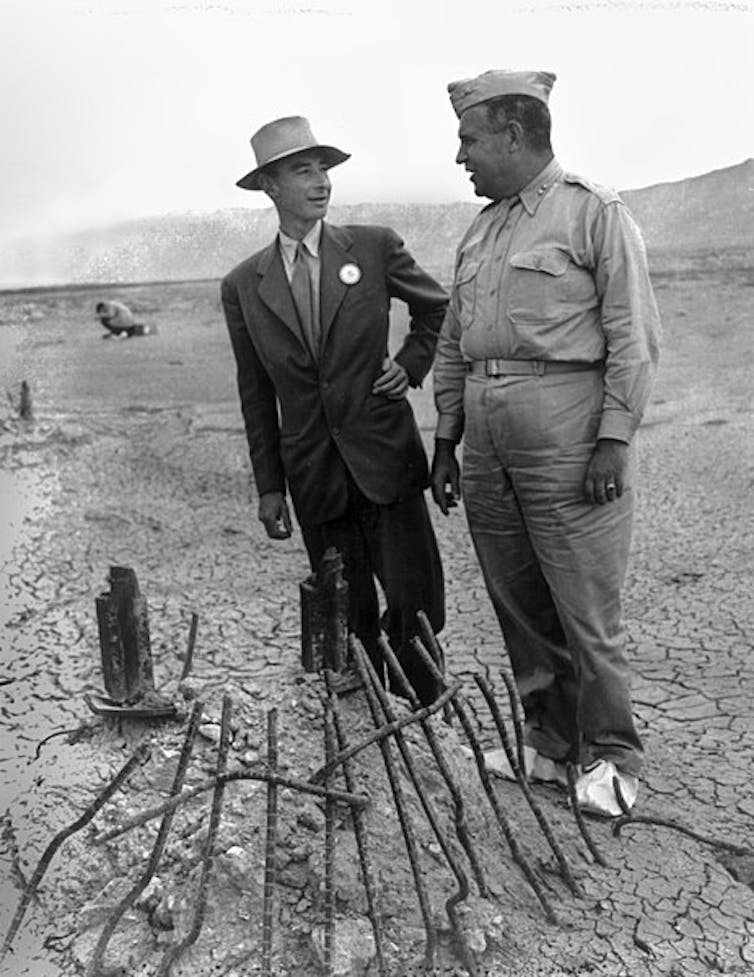
The most famous of Oppenheimer’s words to describe Trinity, the lines from the Hindu scripture, the Bhagavad Gita, “Now I am become Death, the Destroyer of Worlds” – first appearing in print in 1948 but frequently repeated subsequently – reinforce this sense of an encounter with divine forces. They are, for instance, the final words in Tom Morton-Smith’s play, Oppenheimer. They are invoked, too, though not actually spoken or sung, when the chorus sings lines from the Gita in John Adams’ opera, Doctor Atomic.
So much part of the mythology are these words, that it’s sometimes erroneously assumed Oppenheimer actually said them at Trinity. His brother Frank’s recollection was that he simply said: “It worked”. It’s important, too, to be wary of where the mythmaking might take us. As the nuclear historian Alex Wellerstein points out, the words from the Gita are unlikely to be the hubristic statement of Oppenheimer’s triumph they might seem. They are often contrasted with the rather blunter assessment of Kenneth Bainbridge, in charge of the test, who commented to Oppenheimer, “Now we are all sons of bitches”.
The phrase’s attraction is, I think, its ambiguity. It’s portentous, but open to interpretation, gesturing toward something important in humanity’s encounter with greater powers (perhaps a Faustian bargain struck between the purity of physics and the real-world horror of military technology) without quite stating it. A similar suggestiveness surely accounts, too, for the proliferation of the famous (but possibly erroneous) story that Trinity was named by Oppenheimer for a metaphysical poem by John Donne:
Batter my heart, three-person’d God, for you
As yet but knock, breathe, shine, and seek to mend;
That I may rise and stand, o’erthrow me, and bend
Your force to break, blow, burn, and make me new.
It opens up interesting creative possibilities. In her novel Trinity, Louisa Hall imagines Donne’s poem to be one admired by Jean Tatlock, with whom Oppenheimer had an intense relationship, but who died in 1944. In Doctor Atomic, the poem’s words comprise the lyrics of the moving aria closing the first act.
Unsurprisingly, Christian traditions of the acquisition of knowledge, and of the relation with God, are also invoked at Trinity. Oppenheimer famously stated in a lecture in 1947 that “the physicists have known sin”, a statement controversial among his colleagues.
There is, then, a furious mythmaking around both Trinity and Oppenheimer. It transforms Oppenheimer from an actual person into a compelling tragic figure. It transforms the atomic bomb into a technology that symbolises broader anxieties about the relations between ourselves, our technologies and the Earth.
Beauty and terror
Stories about the atomic explosion also conjure up the aesthetic tradition of the sublime, perhaps the dominant means through which encounters with nature have been processed in western societies since the Romantic period. In the art of the sublime, extremity of experience – the wildness and grandeur of nature one might encounter in a storm at sea, for instance – is emphasised.
The sublime evokes both beauty and terror. For Farrell, Groves’s deputy, the explosion was “magnificent, beautiful” and “terrifying”. In Ellen Klages’ young adult novel, The Green Glass Sea, a witness describes Trinity, saying “It was beautiful. It was terrifying”. These are experiences of awe in the sense defined by the Oxford English Dictionary: “a feeling of fear or dread, mixed with profound reverence, typically as inspired by God or the divine”.
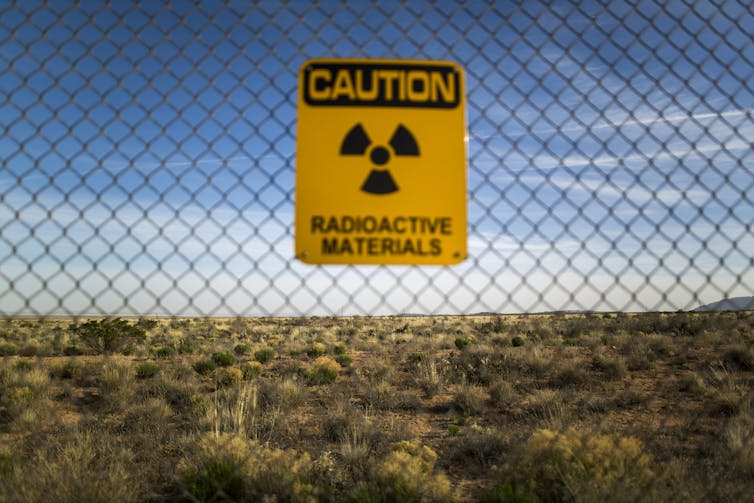
Indeed, Edwin McMillan, one of the physicists, described “the immediate reaction of the watchers as one of awe” and Frisch, Farrell, Bainbridge and Robert Wilson all use the word “awesome” to describe their own responses.
Farrell said of the test that it appeared as “that beauty that great poets dream about but describe most poorly and inadequately”. He is, in fact, remarkably eloquent, as this description of the desert landscape, lit by Trinity, shows:
The whole country was lighted by a searing light with the intensity many times that of the midday sun. It was golden, violet, grey and blue. It lighted every peak, crevasse and ridge of the nearby mountain range with clarity and beauty that cannot be described but must be seen to be imagined.
Pearl Buck’s novel about the Manhattan Project, Command the Morning (1959), seems to draw on this description. Stephen Coast, a (fictional) project scientist, sees:
The sky burst into blinding light. Miles away the mountains were black and then glittered into brilliant relief in the searing light. Colour splashed over the landscape, yellow, purple, crimson, grey. Every fold in the mountain sprang into bold lines, every valley was revealed, every peak stood stark.
The proliferation of adjectives chase after the experience as if they can’t keep up with the boiling profusion of colours. Characteristically, here, the sublime exceeds language’s capacity to capture it.
Trinitite and transmutation
Of course, what’s important about eyewitness and literary descriptions is not merely that they fit Trinity into established aesthetic traditions, but that the fit is uncomfortable. There are religious connotations to the dazzling light and overwhelming power of the explosion, but the forces encountered aren’t divine. Feelings aroused by the sublime are displaced uncannily when the source is technology, not nature.
In an essay on the atomic sublime, the scholar, Peter Hales, shows how the threat of the mushroom cloud was eventually somewhat tamed by being mediated through the aesthetics of the sublime. Trinity, though, provides a compelling origin story in nuclear mythologies precisely because in 1945 it was too new to be contained by that tradition. Even the familiar term, “mushroom cloud”, wasn’t yet readily available to name what rose into the sky (Frisch thought it both “a bit like a strawberry … slowly rising into the sky from the ground, with which it remained connected by a lengthening stem of whirling dust”, and “a red-hot elephant standing balanced on its trunk”).
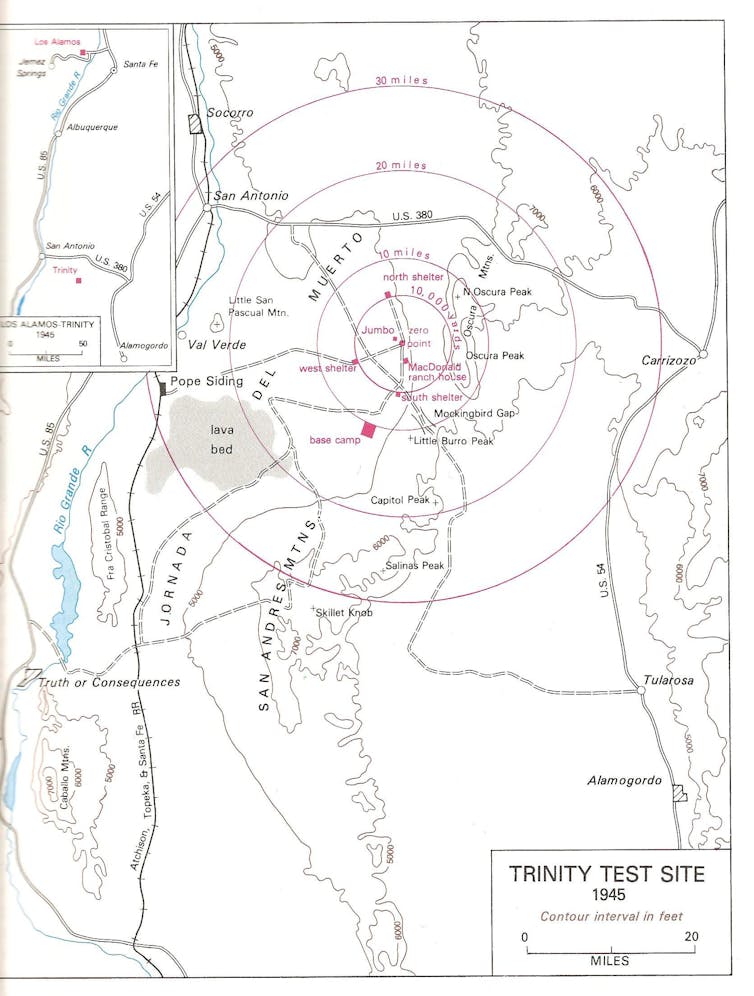
Trinity is unsettling. The experience evoked intimations of the world’s end that were later frequently associated with nuclear weapons. George Kistiakowsky, who led the group building explosive lenses for the gadget, said Trinity was “the nearest thing to doomsday that one could possibly imagine”.
As the mushroom cloud boiled upwards, one military official, perhaps spooked by Enrico Fermi’s mischievous taking of bets on whether the explosion would ignite the atmosphere and, if so, whether it would destroy the whole world or just New Mexico (a possibility actually discussed, but ruled out well in advance of the test), apparently lost faith in the “long-hairs”, as the scientists were sometimes referred to by the soldiers at Los Alamos. “My God,” he’s said to have exclaimed, “the long-hairs have lost control!”.
Trinity presaged an era when the absurdity of extinction replaced a divinely ordained judgement day as the dominant vision of the end of the world: Dr Strangelove instead of the Book of Revelation.
Read more: The end of the world: a history of how a silent cosmos led humans to fear the worst
Frequently, then, Trinity is a story about entering an unsettling new era. The Green Glass Sea captures this beautifully. The desert sand was melted by the test into a glassy substance, dubbed trinitite or Alamogordo glass. The novel’s young protagonist traverses this beautiful, alien world, that came into being 75 years ago:
The ground sloped gently downward into a huge green sea. Dewey took a few more steps and saw that it wasn’t water. It was glass. Translucent jade-green glass, everywhere, colouring the bare, empty desert as far ahead as she could see.

For you: more from our Insights series:
The remote British village that built one of the fastest internet networks in the UK
Four experts investigate how the 5G coronavirus conspiracy theory began
To hear about new Insights articles, join the hundreds of thousands of people who value The Conversation’s evidence-based news. Subscribe to our newsletter.

